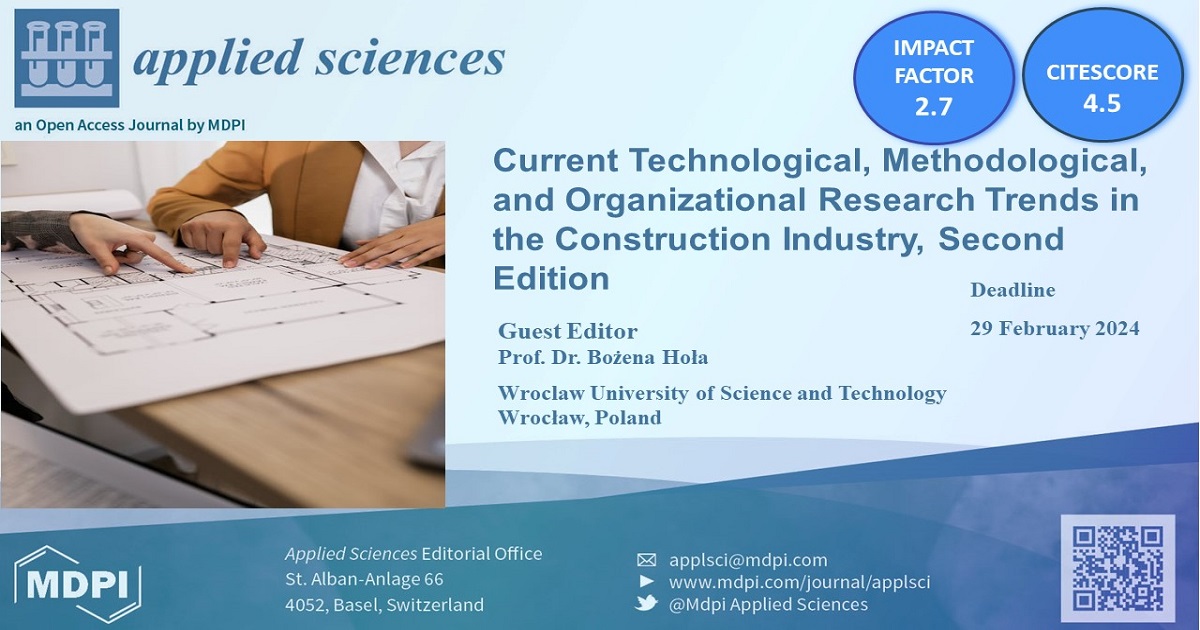Current Technological, Methodological, and Organizational Research Trends in the Construction Industry, Second Edition
A special issue of Applied Sciences (ISSN 2076-3417). This special issue belongs to the section "Civil Engineering".
Deadline for manuscript submissions: 20 July 2024 | Viewed by 3601

Special Issue Editor
Interests: safety and health protection in construction processes; modeling of accidents; phenomenon analysis of the causes of accidents; accident assessment; risks and hazards; construction management; modeling deterministic and probabilistic construction processes; the use of artificial intelligence methods in solving decision problems in construction
Special Issues, Collections and Topics in MDPI journals
Special Issue Information
Dear Colleagues,
Rapid economic development, which is also noticeable in the construction industry, generates many new scientific problems that must be addressed, e.g., in order to meet the requirements of the modern economy. The avenues of scientific research are not only aimed at the continuous improvement of the technology used to erect new facilities, increasing the level of occupational safety, and reducing construction time and costs, but also at increasing the durability of existing structures from different stylistic periods.
These goals can be achieved by various means, including the use of modern technologies in construction projects, the automation and robotization of construction processes, the use of modern information technologies, and the development of modern methods of planning, organizing, and managing construction processes. This Special Issue aims to present the latest developments in this area.
We welcome original manuscripts concerning, but not limited to, the following:
- Modern solutions concerning devices that are used in the construction industry, including the automation and robotization of construction processes, with particular emphasis on the risks and hazards associated with them;
- Modern technological and organizational solutions in the construction industry, including research methods and ways of securing structures and building objects from different stylistic periods;
- The latest information technologies addressing the various problems that occur in the investment process;
- Interdisciplinary research related to occupational safety, including accident modeling, occupational risk assessment, risk management, and occupational safety, as well as the impact of automation and robotization on occupational safety;
- Applications of virtual reality (VR) technology for research and training purposes;
- Methods used in forecasting processes, events, and phenomena that may occur in the future in the construction industry.
Prof. Dr. Bożena Hoła
Guest Editor
Manuscript Submission Information
Manuscripts should be submitted online at www.mdpi.com by registering and logging in to this website. Once you are registered, click here to go to the submission form. Manuscripts can be submitted until the deadline. All submissions that pass pre-check are peer-reviewed. Accepted papers will be published continuously in the journal (as soon as accepted) and will be listed together on the special issue website. Research articles, review articles as well as short communications are invited. For planned papers, a title and short abstract (about 100 words) can be sent to the Editorial Office for announcement on this website.
Submitted manuscripts should not have been published previously, nor be under consideration for publication elsewhere (except conference proceedings papers). All manuscripts are thoroughly refereed through a single-blind peer-review process. A guide for authors and other relevant information for submission of manuscripts is available on the Instructions for Authors page. Applied Sciences is an international peer-reviewed open access semimonthly journal published by MDPI.
Please visit the Instructions for Authors page before submitting a manuscript. The Article Processing Charge (APC) for publication in this open access journal is 2400 CHF (Swiss Francs). Submitted papers should be well formatted and use good English. Authors may use MDPI's English editing service prior to publication or during author revisions.





